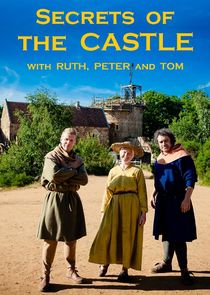Secrets of the Castle with Ruth, Peter and Tom S01E01 - Episode 1

Sinopse
Historian Ruth Goodman and archaeologists Peter Ginn and Tom Pinfold turn the clock back as they learn how to build a medieval castle using the tools, techniques and materials available in the 13th century.
Although Britain has some of the finest remaining castles of the medieval period, many of their secrets have been lost in time.
Peter and Tom set to work straight away, learning the skills of the medieval stonemasons to construct a beautiful spiral staircase. After digging stone out of the quarry, they take it to the tracing floor, where every stone is marked out using the most closely guarded knowledge of the medieval castle builders: geometry. Then each step is hand-carved, a three-day task, before being winched into place using the treadmill-powered crane.
Meanwhile, Ruth sets about equipping the simple wattle and daub hovel that is to be their base. She experiments by laying a rush floor, and she commissions clay-cooking pots and an oak grain arc to store their wheat and barley. Medieval saws were incredibly expensive, so the arc is carved with an axe and assembled without nails.
It becomes clear that all the stone, wood, mortar, dyes, food and water required for the castle needed to be sourced from the surrounding landscape - transporting heavy goods in the 13th century was expensive. One of the most important resources on a medieval building site was water, so Peter visits a wood turner to make a pulley, and Tom makes a rope to hoist the bucket from the well. As they enjoy a simple meal of barley and vegetable pottage, they reflect that there are no easy jobs in the medieval age!
Informações
- Status: Transmitido
- Data de Exibição: 18/11/2014
- Duração do Episódio: 60 minutos
- Emissora:
 BBC Two
BBC Two